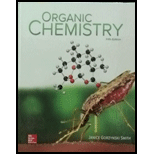
Concept explainers
(a)
Interpretation: The given compound is to be classified as aromatic, antiaromatic or not aromatic.
Concept introduction: A molecule must be cyclic, planar, completely conjugated and should follow
According to the Huckel’s rule the number of
(b)
Interpretation: The given compound is to be classified as aromatic, antiaromatic or not aromatic.
Concept introduction: A molecule must be cyclic, planar, completely conjugated and should follow Huckel’s rule to be classified as aromatic. For an antiaromatic molecule, the molecule must be cyclic, planar, completely conjugated and have
According to the Huckel’s rule the number of
(c)
Interpretation: The given compound is to be classified as aromatic, antiaromatic or not aromatic.
Concept introduction: A molecule must be cyclic, planar, completely conjugated and should follow Huckel’s rule to be classified as aromatic. For an antiaromatic molecule, the molecule must be cyclic, planar, completely conjugated and have
According to the Huckel’s rule the number of
Want to see the full answer?
Check out a sample textbook solution
Chapter 17 Solutions
ORGANIC CHEMISTRY-W/ACCESS >CUSTOM<
- Which compounds are anti aromatic? What do they mean by “assume planarity”arrow_forwardDraw the structure of A, an intermediate in the synthesis of the antipsychotic drug risperidone. Explain why three rings in risperidone are considered aromatic.arrow_forwardexplain whether A,B, C and D are aromatic, anti-aromatic or non-aromaticarrow_forward
- a.Draw all reasonable resonance structures for pyrrole, and explain why pyrrole is less resonance stabilized than benzene. b.Draw all reasonable resonance structures for furan, and explain why furan is less resonance stabilized than pyrrole.arrow_forwardDraw the structure of A, an intermediate in the synthesis of theantipsychotic drug risperidone. Explain why three rings in risperidone are considered aromatic.arrow_forwarda.How many π electrons does C contain? b.How many π electrons are delocalized in the ring? c.Explain why C is aromatic.arrow_forward
- The purine heterocycle occurs commonly in the structure of DNA.a.How is each N atom hybridized? b.In what type of orbital does each lone pair on a N atom reside? c.How many π electrons does purine contain? d.Why is purine aromatic?arrow_forwardI need help with compound B and C!arrow_forwardZolpidem (trade name Ambien) promotes the rapid onset of sleep, making it a widely prescribed drug for treating insomnia. a.In what type of orbital does the lone pair on each N atom in the heterocycle reside? b. Explain why the bicyclic ring system that contains both N atoms is aromatic. c.Draw all reasonable resonance structures for the bicyclic ring system.arrow_forward
 ChemistryChemistryISBN:9781305957404Author:Steven S. Zumdahl, Susan A. Zumdahl, Donald J. DeCostePublisher:Cengage Learning
ChemistryChemistryISBN:9781305957404Author:Steven S. Zumdahl, Susan A. Zumdahl, Donald J. DeCostePublisher:Cengage Learning ChemistryChemistryISBN:9781259911156Author:Raymond Chang Dr., Jason Overby ProfessorPublisher:McGraw-Hill Education
ChemistryChemistryISBN:9781259911156Author:Raymond Chang Dr., Jason Overby ProfessorPublisher:McGraw-Hill Education Principles of Instrumental AnalysisChemistryISBN:9781305577213Author:Douglas A. Skoog, F. James Holler, Stanley R. CrouchPublisher:Cengage Learning
Principles of Instrumental AnalysisChemistryISBN:9781305577213Author:Douglas A. Skoog, F. James Holler, Stanley R. CrouchPublisher:Cengage Learning Organic ChemistryChemistryISBN:9780078021558Author:Janice Gorzynski Smith Dr.Publisher:McGraw-Hill Education
Organic ChemistryChemistryISBN:9780078021558Author:Janice Gorzynski Smith Dr.Publisher:McGraw-Hill Education Chemistry: Principles and ReactionsChemistryISBN:9781305079373Author:William L. Masterton, Cecile N. HurleyPublisher:Cengage Learning
Chemistry: Principles and ReactionsChemistryISBN:9781305079373Author:William L. Masterton, Cecile N. HurleyPublisher:Cengage Learning Elementary Principles of Chemical Processes, Bind...ChemistryISBN:9781118431221Author:Richard M. Felder, Ronald W. Rousseau, Lisa G. BullardPublisher:WILEY
Elementary Principles of Chemical Processes, Bind...ChemistryISBN:9781118431221Author:Richard M. Felder, Ronald W. Rousseau, Lisa G. BullardPublisher:WILEY





